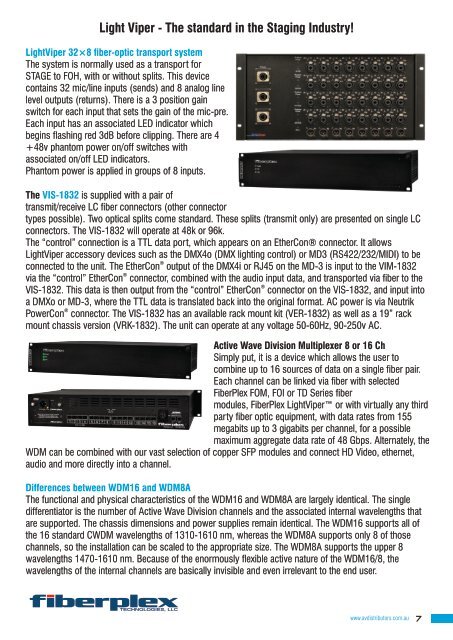Create successful ePaper yourself
Turn your PDF publications into a flip-book with our unique Google optimized e-Paper software.
Light Viper - The st<strong>and</strong>ard in the Staging Industry!<br />
LightViper 32×8 ber-optic transport system<br />
The system is normally used as a transport for<br />
STAGE to FOH, with or without splits. This device<br />
contains 32 mic/line inputs (sends) <strong>and</strong> 8 analog line<br />
level outputs (returns). There is a 3 position gain<br />
switch for each input that sets the gain of the mic-pre.<br />
Each input has an associated LED indicator which<br />
begins ashing red 3dB before clipping. There are 4<br />
+48v phantom power on/off switches with<br />
associated on/off LED indicators.<br />
Phantom power is applied in groups of 8 inputs.<br />
The VIS-1832 is supplied with a pair of<br />
transmit/receive LC ber connectors (other connector<br />
types possible). Two optical splits come st<strong>and</strong>ard. These splits (transmit only) are presented on single LC<br />
connectors. The VIS-1832 will operate at 48k or 96k.<br />
The “control” connection is a TTL data port, which appears on an EtherCon® connector. It allows<br />
LightViper accessory devices such as the DMX4o (DMX lighting control) or MD3 (RS422/232/MIDI) to be<br />
®<br />
connected to the unit. The EtherCon output of the DMX4i or RJ45 on the MD-3 is input to the VIM-1832<br />
®<br />
via the “control” EtherCon connector, combined with the audio input data, <strong>and</strong> transported via ber to the<br />
®<br />
VIS-1832. This data is then output from the “control” EtherCon connector on the VIS-1832, <strong>and</strong> input into<br />
a DMXo or MD-3, where the TTL data is translated back into the original format. AC power is via Neutrik<br />
®<br />
PowerCon connector. The VIS-1832 has an available rack mount kit (VER-1832) as well as a 19” rack<br />
mount chassis version (VRK-1832). The unit can operate at any voltage 50-60Hz, 90-250v AC.<br />
Active Wave Division Multiplexer 8 or 16 Ch<br />
Simply put, it is a device which allows the user to<br />
combine up to 16 sources of data on a single ber pair.<br />
Each channel can be linked via ber with selected<br />
FiberPlex FOM, FOI or TD Series ber<br />
modules, FiberPlex LightViper or with virtually any third<br />
party ber optic equipment, with data rates from 155<br />
megabits up to 3 gigabits per channel, for a possible<br />
maximum aggregate data rate of 48 Gbps. Alternately, the<br />
WDM can be combined with our vast selection of copper SFP modules <strong>and</strong> connect HD Video, ethernet,<br />
audio <strong>and</strong> more directly into a channel.<br />
Differences between WDM16 <strong>and</strong> WDM8A<br />
The functional <strong>and</strong> physical characteristics of the WDM16 <strong>and</strong> WDM8A are largely identical. The single<br />
differentiator is the number of Active Wave Division channels <strong>and</strong> the associated internal wavelengths that<br />
are supported. The chassis dimensions <strong>and</strong> power supplies remain identical. The WDM16 supports all of<br />
the 16 st<strong>and</strong>ard CWDM wavelengths of 1310-1610 nm, whereas the WDM8A supports only 8 of those<br />
channels, so the installation can be scaled to the appropriate size. The WDM8A supports the upper 8<br />
wavelengths 1470-1610 nm. Because of the enormously exible active nature of the WDM16/8, the<br />
wavelengths of the internal channels are basically invisible <strong>and</strong> even irrelevant to the end user.<br />
www.avdistributors.com.au<br />
7



